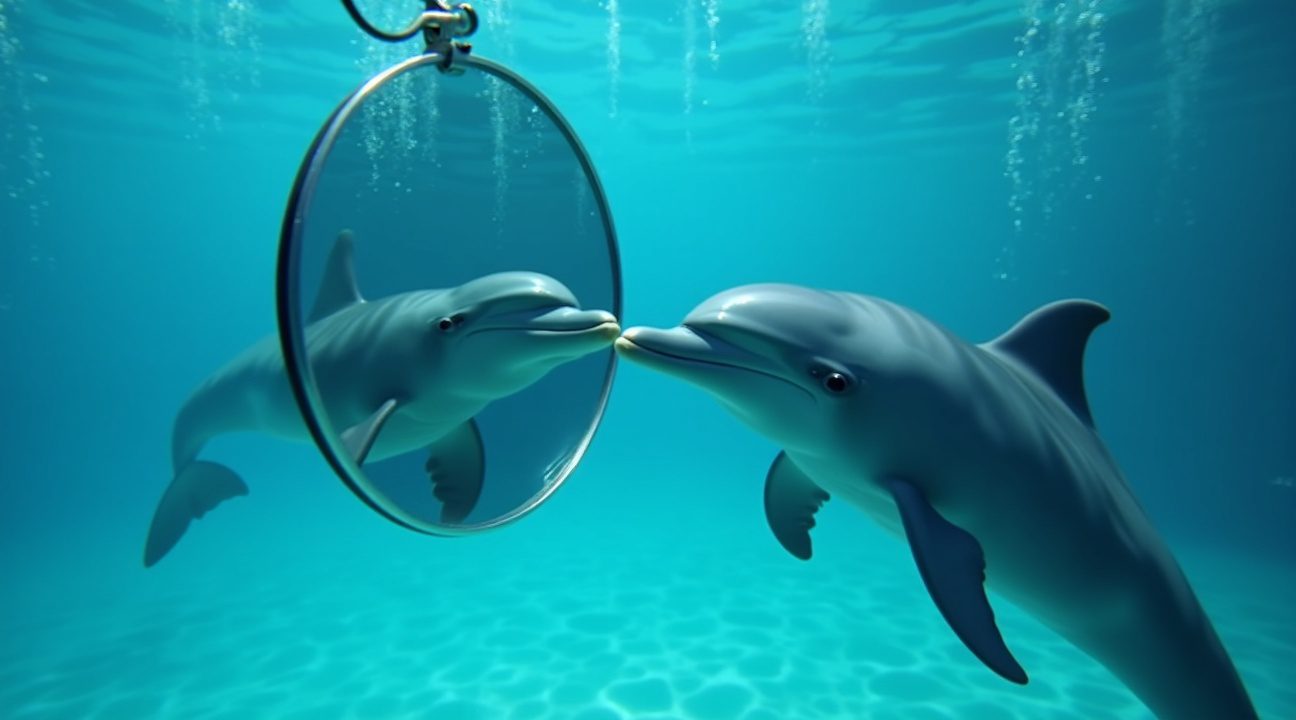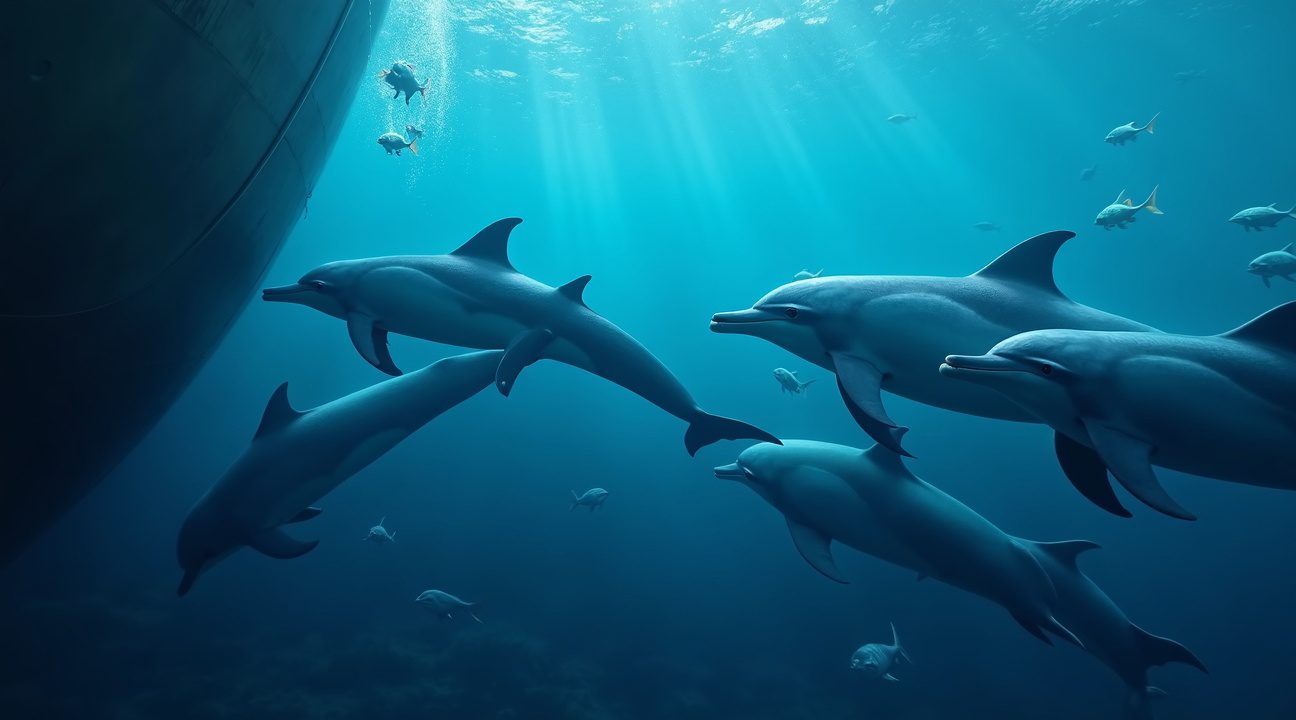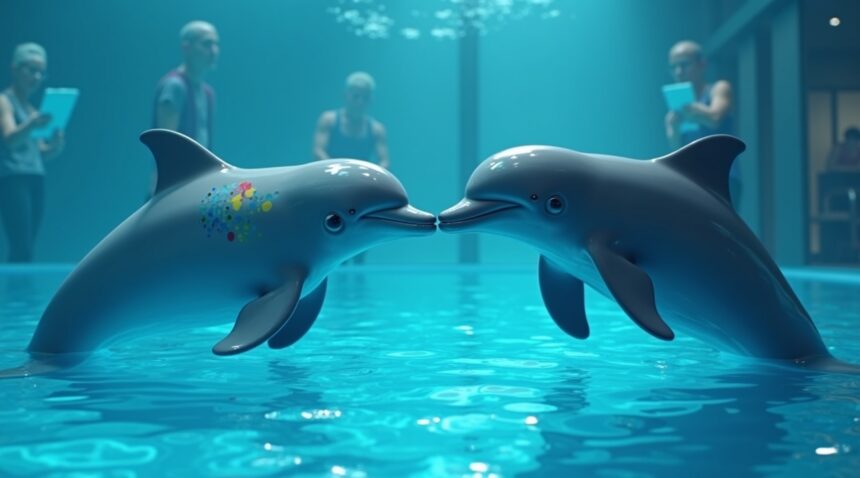Dolphins demonstrate mirror self-recognition at just seven months old, showcasing cognitive abilities that exceed human developmental timelines by more than a year. This achievement places them among an elite group of self-aware species. Their larger, more complex brains with specialized neural architecture enable this remarkable early development of self-awareness. Scientists measure this ability through carefully controlled mark tests that reveal dolphins’ capacity to recognize and examine their own reflections.
Key Takeaways
- Dolphins master mirror self-recognition at 7 months old, significantly earlier than humans who typically develop this ability between 18–24 months of age.
- Only a select few species can pass the mirror self-recognition test, including dolphins, great apes, elephants, and certain corvids like magpies.
- Dolphin brains are larger and more complex than human brains, weighing approximately 1,600 grams with greater cortical surface area that supports advanced cognitive processing.
- Aquarium environments may accelerate dolphin self-awareness development through daily exposure to reflective surfaces and enhanced sensory integration capabilities.
- The sophisticated social intelligence of dolphins, which enables cooperative hunting and complex communication systems, directly correlates with their mirror self-recognition abilities.
For more scientific insight into dolphin cognition, visit this resource provided by the National Geographic article on dolphin intelligence.
Seven-Month-Old Dolphins Master What Humans Learn at Two Years
Dolphins display remarkable cognitive abilities that emerge surprisingly early in their development. At just seven months old, these marine mammals can exhibit self-recognition capabilities that surpass many primates and exceed human developmental timelines by more than a year. Human children typically demonstrate mirror self-recognition around 18-24 months of age, making dolphin achievements in this area particularly noteworthy.
The Mark Test Reveals Advanced Self-Awareness
Researchers use the mark test as the primary method for assessing mirror self-recognition in dolphins. This experimental approach involves several key components that help scientists determine whether an animal truly recognizes itself:
- Placing a visible mark on the dolphin’s body in a location only viewable through a mirror
- Observing whether the animal inspects or interacts with the marked area when presented with its reflection
- Comparing behaviors when marks are visible versus hidden or placed on other dolphins
- Documenting self-directed movements that indicate intentional examination of specific body parts
Bottlenose dolphins consistently demonstrate self-directed behaviors when confronted with mirrors during these experiments. They position themselves to examine marked areas, twist their bodies to get better viewing angles, and spend significantly more time investigating visible marks compared to control conditions. This behavior pattern strongly suggests genuine self-recognition rather than mere curiosity about another dolphin or random movement.
The cognitive implications of early mirror self-recognition extend far beyond simple visual processing. Dolphins must possess several sophisticated mental capabilities to pass the mark test successfully. They need to:
- Understand that the reflection represents their own body rather than another individual
- Coordinate their movements with the mirrored image
- Demonstrate intentional behavior directed at specific body locations
Scientists have documented that dolphins show heightened interest in their reflections when marks are present compared to unmarked encounters. This differential response indicates that the animals recognize something unusual about their appearance and actively investigate the change. Such behavior demonstrates not only self-awareness but also an understanding of their normal physical state versus an altered condition.
The seven-month milestone represents a critical developmental period for dolphin cognition. At this age, these marine mammals have already developed the neural complexity necessary for self-recognition, suggesting that their brains mature rapidly in areas associated with self-awareness and higher-order thinking. This early development timeline positions dolphins among the most cognitively advanced species on the planet.
Experimental findings consistently show that dolphins engage in purposeful, self-directed examination when presented with mirrors and marks. They don’t simply swim past their reflections or treat the mirror as a social encounter with another dolphin. Instead, they demonstrate clear recognition that the image represents themselves and actively use the mirror as a tool for self-examination.
The mark test results have broad implications for understanding dolphin intelligence and consciousness. Animals that can recognize themselves in mirrors possess a level of self-awareness that correlates with other advanced cognitive abilities, including problem-solving, empathy, and complex social behaviors. Dolphins’ early mastery of this skill suggests their cognitive development follows an accelerated timeline compared to many other intelligent species.
These findings challenge traditional assumptions about cognitive development timelines across species. While unusual phenomena in nature often surprise researchers, dolphin self-recognition abilities represent a consistent and well-documented cognitive achievement that occurs remarkably early in their lives.

The Exclusive Club of Mirror-Aware Animals
Dolphins belong to an incredibly select group of species that can recognize themselves in mirrors, demonstrating a level of self-awareness that scientists consider a hallmark of advanced intelligence. This exclusive club includes only a handful of non-human animals that consistently pass the mirror self-recognition test, making their cognitive abilities all the more remarkable.
The mirror self-recognition test serves as a crucial benchmark for measuring self-awareness across different species. When researchers place animals in front of mirrors and mark their bodies with visible spots or colors, only the most cognitively advanced species will use the reflection to examine these markings on themselves rather than treating the mirror image as another animal.
Developmental Timeline Across Species
The timeline for developing mirror self-recognition varies significantly across species, revealing fascinating insights about cognitive development. Each species demonstrates unique behaviors and reaches this milestone at different stages of their development:
- Bottlenose dolphins achieve mirror-directed behaviors by 7 months, using their reflections to inspect markings placed on their bodies
- Human children develop this ability between 18-24 months, typically touching or inspecting marks on their face or body when viewing themselves in mirrors
- Chimpanzees reach self-recognition around 2 years of age, carefully inspecting and touching marked areas while looking at their reflections
- Asian elephants demonstrate this capability at an undetermined age, using their versatile trunks to investigate marks they observe in mirrors
- Magpies and other corvids employ their beaks to inspect colored spots they notice in their reflections
The remarkably early emergence of self-recognition in dolphins stands out even among this elite group. At just 7 months, these marine mammals display behaviors that indicate they understand the mirror shows their own body rather than that of another dolphin. This early development underscores their exceptional cognitive abilities and places them at the forefront of animal intelligence research.
Great apes, including chimpanzees, bonobos, and orangutans, form another significant portion of this exclusive group. Their mirror recognition abilities have been extensively studied, providing researchers with valuable comparison points for understanding how self-awareness develops across different evolutionary lineages.
Asian elephants represent the largest animals capable of mirror self-recognition, using their highly sensitive trunks to explore markings they observe in reflections. Their success in this test highlights how intelligence can manifest differently across species with vastly different physical capabilities and evolutionary histories.
Perhaps most surprising to many people is the inclusion of certain birds in this elite group. Magpies and other corvids have demonstrated clear evidence of mirror self-recognition, challenging long-held assumptions about which types of animals possess self-awareness. These birds use their beaks with precision to investigate colored spots they see reflected back at them, proving that advanced cognition isn’t limited to mammals.
The comparative study of mirror self-recognition across these species reveals important patterns about intelligence and consciousness in the animal kingdom. Each species has developed unique strategies for using mirrors to examine themselves, reflecting their distinct anatomical features and behavioral repertoires. Dolphins use their exceptional maneuverability in water, elephants employ their remarkably dexterous trunks, and corvids utilize their sharp beaks and keen eyesight.
Scientists continue studying these remarkable abilities to better understand the evolution of self-awareness and consciousness. The fact that such diverse species – from marine mammals to terrestrial giants to aerial acrobats – have independently evolved this capacity suggests that self-recognition may be more fundamental to advanced cognition than previously thought.
This exclusive group of mirror-aware animals provides researchers with valuable insights into the nature of intelligence itself, helping to map the cognitive landscape that separates the most mentally sophisticated creatures from the rest of the animal kingdom.

Dolphin Brains Outsize and Outperform Human Brains in Key Areas
I find it remarkable that dolphins possess brains weighing approximately 1,600 grams, significantly larger than the human average of 1,300 grams. These marine mammals don’t just have bigger brains—they’ve got more complex ones too. Their cortical surface area spans about 3,700 cm², substantially exceeding the human average of 2,400 cm². This increased convolution creates more surface area for neural processing, which explains why dolphins demonstrate such advanced cognitive abilities like self-recognition in mirrors.
Advanced Neural Architecture Powers Self-Awareness
The prefrontal cortex in dolphins deserves special attention since this brain region handles executive functions and self-reflection in humans. Researchers have anatomically mapped this area and discovered connectivity patterns strikingly similar to those found in human brains, despite millions of years of evolutionary separation. This similarity suggests that self-awareness may arise from comparable neural mechanisms across different species.
What makes dolphin brains truly exceptional is their neocortex and paralimbic lobe structure. The paralimbic lobe, which appears less distinctly defined in humans, contributes to sophisticated social cognition and emotional processing in dolphins. This specialized brain architecture helps explain why dolphins excel at complex social behaviors and can recognize themselves in reflective surfaces.
Superior Neural Density Drives Cognitive Performance
The neuron density within the dolphin neocortex surpasses that found in both humans and chimpanzees. This packed neural arrangement creates a brain specialized for dual processing:
- Social-cognitive functions
- Acoustic-sensory processing
Such neural efficiency allows dolphins to process complex echolocation data while maintaining awareness of their social environment and even their own identity.
This high-density neural network enables dolphins to perform cognitive tasks that require significant self-awareness. The combination of large brain size, complex folding patterns, and dense neural packing creates a biological foundation for advanced intelligence. When dolphins look into mirrors and recognize themselves, they’re demonstrating the computational power of a brain that has evolved specialized structures for both self-reflection and environmental processing.
The structural similarities between dolphin and human prefrontal cortices suggest that self-awareness might represent a convergent evolutionary solution for intelligent species. Despite following different evolutionary paths, both humans and dolphins developed neural architectures capable of supporting complex self-recognition abilities.
Why Aquarium Life May Give Dolphins a Self-Awareness Advantage
Aquarium environments create unique conditions that may accelerate dolphin self-recognition abilities compared to other species. Dolphins housed in these facilities encounter reflective surfaces daily through pool walls, water surfaces, and various glass barriers. This constant exposure familiarizes them with their own reflected images long before researchers introduce formal mirror tests.
The regular interaction with reflections reduces what scientists call the “novelty effect” that often confuses other animals during mirror experiments. Wild dolphins occasionally see their reflections in calm water, but captive dolphins experience this phenomenon multiple times throughout each day. This environmental advantage may explain why dolphins in controlled studies demonstrate more immediate recognition behaviors and spend less time investigating their reflections compared to animals tested in completely novel mirror situations.
Enhanced Sensory Integration Supports Visual Recognition
Dolphin brains allocate considerable cortical space to processing acoustic information and integrating multiple sensory inputs simultaneously. This neural architecture enables what researchers term cross-modal perception – the ability to combine information from different senses to create a unified understanding of their environment. The integration proves particularly valuable for self-recognition because dolphins can correlate visual mirror images with their own echolocation calls and physical sensations.
The sophisticated sensory processing capabilities extend beyond simple recognition tasks. Dolphins demonstrate remarkable cooperation skills and vocal learning abilities that require advanced social cognition. These cognitive foundations support the complex mental processes necessary for understanding that a mirror reflection represents their own body rather than another dolphin.
Bottlenose dolphins show especially advanced self-awareness behaviors in aquarium settings, often using mirrors to inspect parts of their bodies they cannot normally see. Scientists have observed dolphins positioning themselves strategically to examine their undersides or checking for marks placed on their bodies during experiments. Strange phenomena in nature continue to fascinate researchers studying animal cognition.
The aquarium advantage extends beyond mere exposure frequency. These controlled environments allow dolphins to develop more sophisticated relationships with reflective surfaces. Young dolphins often play with their reflections, gradually learning to distinguish between their own movements and those of other dolphins. This playful interaction accelerates the development of self-recognition skills that might take longer to emerge in wild populations.
Research suggests that advanced technology helps scientists better understand these cognitive processes. The combination of frequent reflection exposure and enhanced sensory integration creates optimal conditions for developing self-awareness. Dolphins in aquariums essentially receive continuous training in visual self-recognition, giving them substantial advantages over species tested without such preparation.
The acoustic environment in aquariums also contributes to this advantage. Dolphins can hear their own vocalizations reflected off pool walls and associate these sounds with their visual appearance in mirrors. This audio-visual correlation strengthens their understanding of self-identity and supports faster recognition during formal testing procedures.
Environmental enrichment programs in modern aquariums often include reflective elements specifically designed to stimulate cognitive development. These programs recognize that regular exposure to mirrors and reflective surfaces promotes mental stimulation and supports the natural development of self-awareness abilities. The structured nature of aquarium life provides dolphins with consistent opportunities to practice and refine their self-recognition skills.
The research implications extend beyond understanding dolphin intelligence. Scientists studying complex gaming environments note similar patterns where repeated exposure enhances performance. The aquarium environment essentially creates a natural laboratory where dolphins can develop their cognitive abilities through daily interaction with reflective surfaces, demonstrating how environmental factors significantly influence the development and expression of self-awareness in highly intelligent species.
The Social Intelligence Behind Mirror Recognition
Dolphins demonstrate remarkable social intelligence that extends far beyond simple group behavior. These marine mammals engage in coordinated cooperation during hunting, where multiple individuals work together to herd fish into tight formations. I’ve observed how they display sophisticated imitation behaviors, learning new techniques by watching and copying other dolphins in their pod.
Advanced Cognitive Capabilities in Marine Environments
The vocal communication systems dolphins employ reveal extraordinary complexity. They develop unique signature whistles that function as individual names, allowing them to identify and call specific pod members across vast distances. These communication skills demonstrate the same cognitive sophistication that enables mirror self-recognition tasks.
Research into dolphin brain anatomy reveals extensive neocortical surface area that rivals many primates. Imaging studies show specialized brain regions dedicated to processing complex social information and self-referential thinking. This neural infrastructure provides the biological foundation for their ability to recognize themselves in mirrors and understand their place within social hierarchies.
Dolphins coordinate their behaviors with precision that suggests advanced planning abilities. During cooperative hunting, they assign specific roles to different individuals, with some dolphins acting as drivers while others position themselves as blockers. This level of organization requires each dolphin to understand not only their own role but also anticipate the actions of their teammates.
The connection between social intelligence and mirror self-recognition becomes clear when examining how dolphins process information about themselves versus others. They can distinguish between their own reflections and those of other dolphins, indicating a sophisticated understanding of self versus other. This cognitive ability underlies their success in complex social situations where individual identity matters.
Their capacity for vocal learning extends beyond simple mimicry to include creative adaptation of sounds for specific social contexts. Dolphins modify their signature whistles when addressing different individuals, suggesting they understand how communication affects social relationships. This flexibility in vocal behavior reflects the same cognitive processes involved in recognizing themselves as distinct individuals in mirror tests.
Brain imaging technology has revealed that dolphins possess neural pathways similar to those found in other self-aware species. These pathways connect areas responsible for self-recognition with regions that process social information, creating an integrated system for understanding both individual identity and social dynamics. The structural complexity of these neural networks supports their demonstrated abilities in mirror recognition tasks while enabling the sophisticated social behaviors that define dolphin intelligence.

Sources:
Morrison R, Reiss D. “Precocious development of self-awareness in dolphins” — PLOS One
Andreas Huggenberger et al. “The prefrontal cortex of the bottlenose dolphin (Tursiops truncatus): Insights into its anatomy using diffusion-weighted imaging”
Diana Reiss, Rachel Morrison. “How do marked dolphins use mirrors and what does it mean?” — National Library of Medicine (PMC)
“Cetacean intelligence” — Wikipedia
Lori Marino. “Dolphin Mirror Self-Recognition: the Science and the Ethics” — Whale Sanctuary Project


